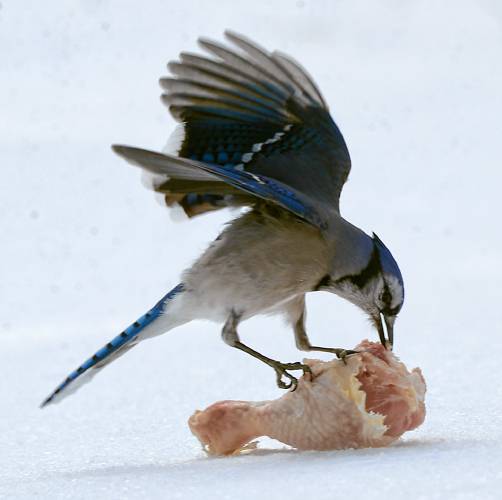Speaking of Nature: Opportunity taken: Omnivorous scavengers eat just about anything during the tough months of winter

A blue jay was seen scavenging on a piece of raw chicken that I had initially intended for a red-tailed hawk. Blue jays are classic omnivores and will take advantage of any food that they find. PHOTO BY BILL DANIELSON
| Published: 03-04-2025 12:22 PM |
Last week I regaled you with a story about a red-tailed hawk. This bird kept showing up in my yard and forlornly staring out across my back yard in the hopes of finding something to eat. At the time, the problem was one of precipitation, or, rather, the precise combination of temperature and precipitation. Snow, followed by rain, followed by prolonged temperatures below freezing had resulted in a landscape that was covered by a thick shell of ice.
As I was writing the column I found myself becoming more and more concerned with the welfare of that hawk and after finishing my writing and sending it in to the paper I got up from my desk and headed for the kitchen; resolved to try to do something. What did I have that I could toss out onto the ice in the hopes of attracting the hawk’s attention?
Well, it turned out that I had recently purchased a tray of delicious-looking chicken drumsticks that were waiting to be turned into a delicious meal … for me. The package contained six drumsticks and I reasoned that I could give one to the hawk and still have plenty for myself. So I took one out onto my deck and chucked it out onto the ice as the hawk looked on. My hope was that the movement of the food would trigger the hawks instincts and compel it into action.
The drumstick hit the surface of the ice and didn’t make a dent in it. There was a very satisfying moment when the chicken slid across the ice, nicely mimicking the movement of a living thing, but the hawk did not respond. A quick look through my binoculars explained everything. The hawk was looking away from me, rather than toward me. Darn it!
I went inside and looked at the tray of chicken. I supposed that I could offer the hawk one more piece and still have plenty left for myself. This time, however, I wanted to get the hawk’s attention before launching the food out onto the ice. So I made some noise, said a few words to the hawk and made my toss. Another perfect throw with the same imperfect result. Double darn it! Once I was back in the kitchen I found the gambler’s bug kick in and I decided to go all in. One final attempt involved throwing all of the remaining chicken out into the yard in an epic volley of generosity. The hawk never flinched. I returned to the kitchen with and empty tray and a head full of disappointment.
The hawk was in the yard for most of that day, but it never seemed to understand that there was food sitting right there. Occasionally I would glance at the pieces of chicken and attempt to use the Jedi mind trick to compel the hawk into motion, but it never worked. But that does not mean the hawk-feeding endeavor was a complete loss. Other birds in the yard quickly took advantage of the new food.
The first bird to react to the chicken on the ice was a black-capped chickadee. I had noticed this while walking past one of the windows and was mildly amazed by this development. A chickadee eating raw chicken? After the initial surprise wore off I grabbed my camera and headed for the basement windows. There, at ground level, I was able to capture some photos that had a background and foreground that was completely white. Suddenly, my own yard looked like the Arctic tundra in winter.
Later that same day I noticed a blue jay standing on top of the same drumstick that the chickadee had found. Much larger and stronger, the jay was able to tear of large chunks of meat and carry them away to a nearby tree. I managed to capture today’s photo in the middle of the jay’s work. Again, the entire world seems to be a pure, unbroken blanket of snow with the only colors provided by the jay and its food. To me, this photo communicates a great deal about the blue jay lifestyle. The ultimate omnivore with the ultimate omnivore’s beak, the blue jay will eat just about anything and will take advantage of every opportunity it is given during the tough months of winter. At one point I was absolutely astounded when I noticed a gray squirrel eating bits of the raw chicken.
Article continues after...
Yesterday's Most Read Articles
 Local ‘Hands Off!’ standouts planned as part of national effort
Local ‘Hands Off!’ standouts planned as part of national effort
 Incandescent Brewing now open in Bernardston
Incandescent Brewing now open in Bernardston
 Two arrested on drug trafficking charges in Greenfield
Two arrested on drug trafficking charges in Greenfield
 Berkshire DA says no crime occurred in student-officer relationship at Mohawk Trail
Berkshire DA says no crime occurred in student-officer relationship at Mohawk Trail
 Proposed ordinance would make Greenfield a ‘sanctuary city’ for trans, gender-diverse people
Proposed ordinance would make Greenfield a ‘sanctuary city’ for trans, gender-diverse people
 Sounds Local: A legend pays tribute to an icon: Seven-time Grammy-nominated Joan Osborne brings Bob Dylan repertoire to Shea Theater
Sounds Local: A legend pays tribute to an icon: Seven-time Grammy-nominated Joan Osborne brings Bob Dylan repertoire to Shea Theater
The squirrel did not stay long, nor did it return, but there was definitely a moment when the rodent was willing to give it a try; a testament to the desperate conditions created by prolonged ice and cold. The following day it was the local family of crows that descended into my yard. Tremendous excitement could be heard in their voices as they discovered one piece of food after another and a lot of effort was spent ripping and tearing at the meat that was now frozen. However, all of that activity seemed to go unnoticed by the hawk. The raptor came and went over the course of the following days, but it never cued in to the presence of the food that had been put out specifically for it.
Since my adventure with the backyard scavengers there has been a change in the weather. The past week has been much warmer and there are now patches of grass peeking out from underneath the snow. American robins are all over the place and they are optimistically exploring all of these freshly-exposed patches of ground. Some of the birds are starting to sing and spring is showing signs of her approach. It has been a long and lustrous winter, but I am ready for a change.
Bill Danielson has been a professional writer and nature photographer for 28 years. He has worked for the National Park Service, the US Forest Service, the Nature Conservancy and the Massachusetts State Parks and he currently teaches high school biology and physics. For more in formation visit his website at www.speakingofnature.com, or go to Speaking of Nature on Facebook.






 Mill Street Artists displaying work at Hope & Olive in Greenfield
Mill Street Artists displaying work at Hope & Olive in Greenfield Amherst can’t decide where it is: Is town center uptown or downtown?
Amherst can’t decide where it is: Is town center uptown or downtown? ‘She is our future’: Thirty years after permitting women to join, Montague Elks is almost entirely women-led
‘She is our future’: Thirty years after permitting women to join, Montague Elks is almost entirely women-led ‘Art in the Age of Human Impact’: New exhibition at UMass explores complex relationship between humans and nature
‘Art in the Age of Human Impact’: New exhibition at UMass explores complex relationship between humans and nature
